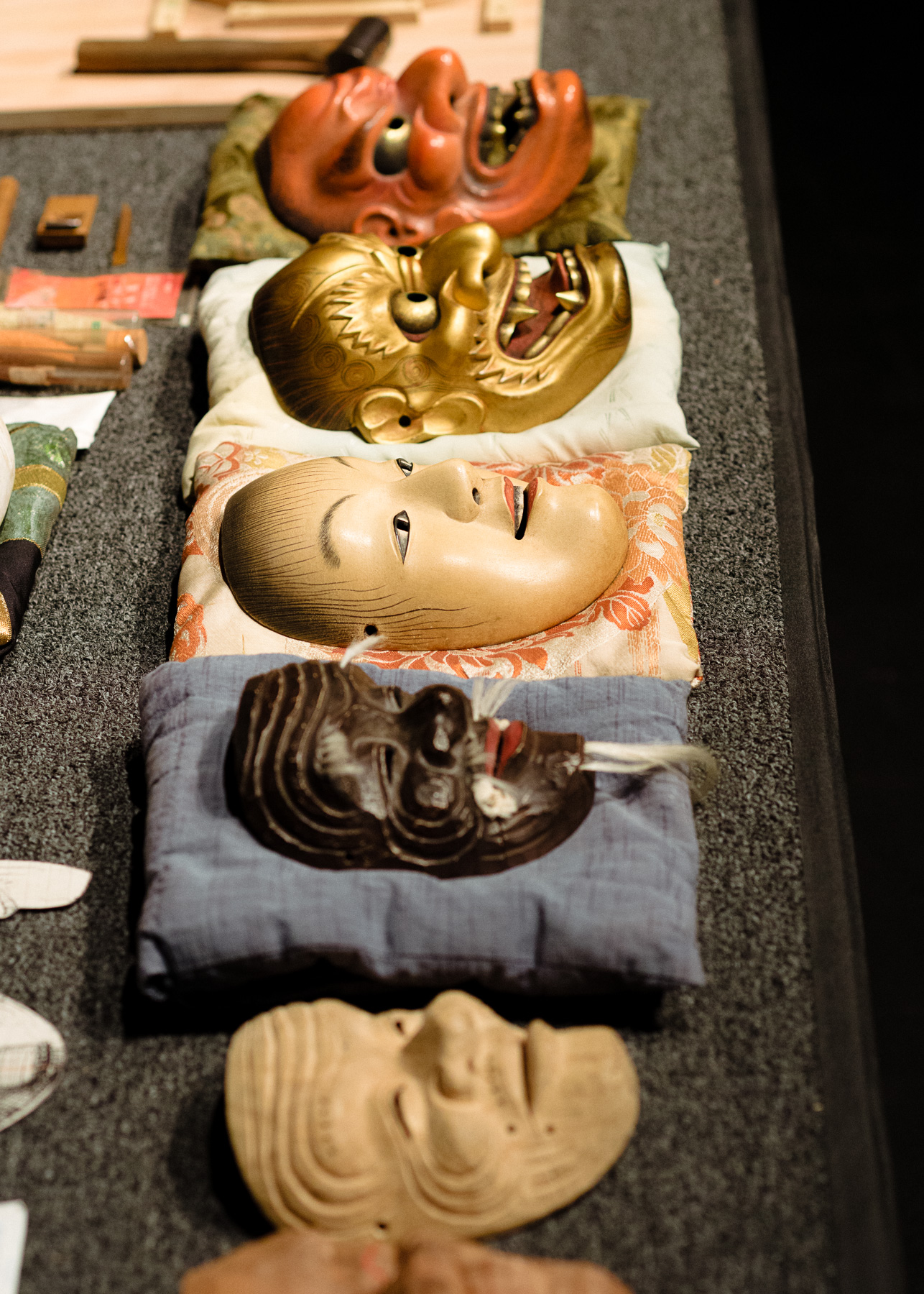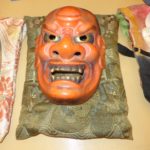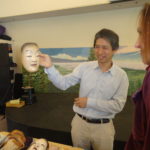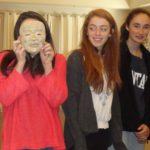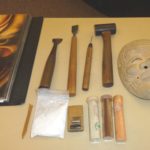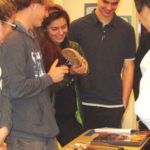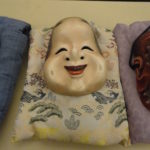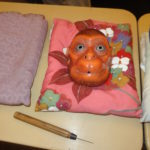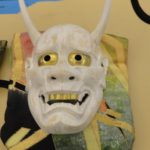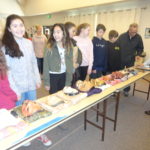 Born into a family of Japanese wood craftsmen, Hideta Kitazawa first started carving when he was five years old. As he grew, he kept at it, learning the techniques and tradition of Noh and Kyogen theatrical mask carving alongside his father. After high school, Kitazawa, like many new graduates, was uncertain about what he wanted to pursue as a career, and so for awhile he attended the University of Tokyo and studied Forestry Management. Then, at 23, Kitazawa realized that he very much wanted to pursue the artistry and craft of traditional mask making, and began a nine-year apprenticeship with a master Noh carver.
Born into a family of Japanese wood craftsmen, Hideta Kitazawa first started carving when he was five years old. As he grew, he kept at it, learning the techniques and tradition of Noh and Kyogen theatrical mask carving alongside his father. After high school, Kitazawa, like many new graduates, was uncertain about what he wanted to pursue as a career, and so for awhile he attended the University of Tokyo and studied Forestry Management. Then, at 23, Kitazawa realized that he very much wanted to pursue the artistry and craft of traditional mask making, and began a nine-year apprenticeship with a master Noh carver.
Recently Kitazawa visited Mount Madonna School (MMS) meeting with middle and high school students, to share an introduction to his work and Noh theatre. The presentation was arranged by Rajesh Westerberg (’89), technical director for theatre arts at the University of California, Santa Cruz (UCSC), who was hosting Kitazawa for a week-long carving workshop and lecture series.
 “Some of my [UCSC] students are carving with Hideta,” Westerberg explained, “and using old growth redwood harvested from around the Mount Madonna campus. There’s so much interest in his work, that it seemed really appropriate to bring him to Mount Madonna for a presentation, as well.”
“Some of my [UCSC] students are carving with Hideta,” Westerberg explained, “and using old growth redwood harvested from around the Mount Madonna campus. There’s so much interest in his work, that it seemed really appropriate to bring him to Mount Madonna for a presentation, as well.”
In addition to carving masks, Kitazawa works with his father to carve intricately-detailed gates for Shinto temples. When MMS High School Director Shannon Kelly (’92) heard about the temple gate carvings, she thought that Kitazawa would be a good fit to talk with MMS seniors, who study Shintoism as part of their World Religions class.
“In World Religions we try our best reach beyond the textbook and allow our students to engage directly with spiritual and religious practices. Mr. Kitazawa comes from a long line of Shinto temple carvers and Noh mask makers. We want our students to understand the intersection between art, ritual, and spiritual practice and felt that speaking with Mr. Kitazawa and witnessing his craft would help them with this.”
The MMS students gathered alongside two narrow tables which displayed about a dozen masks, carefully placed upon traditional makura or buckwheat hull pillows. Kitazawa began with a short slideshow on Noh and Kyogen theatre and talked about the history of the art form and mask symbolism.
 The Noh repertoire consists of some 200 plays, all serious, philosophical dramas. When they are performed, lighter comedic Kyogen stories are interspersed between the acts of a Noh production, to help balance the intensity of the darker stories.
The Noh repertoire consists of some 200 plays, all serious, philosophical dramas. When they are performed, lighter comedic Kyogen stories are interspersed between the acts of a Noh production, to help balance the intensity of the darker stories.
For this type of traditional theatre – performed in Japan since the late thirteenth century – stages are simple and mainly constructed from bamboo and lumber, with props suggestive of items, rather than detailed replicas.
“Noh is not so kind for the audience,” Kitazawa told the students, laughing, “you really have to use your imagination!”
Noh masks are usually carved from Japanese Cypress and are considered valuable heirlooms to be passed from generation to generation.
A unique feature of this type of wooden mask is that most exteriors are finished with a “neutral” expression, and instead rely upon the actor wearing the mask to communicate emotion through terasu, an upward turn that changes the expression to a slight smile or more of laugh; or kumorasu, a downward tilt that can conveys a slight frown, sadness or anger.
 “It’s the same rigid mask, but it can appear to have so many expressions,” said Westerberg. “The lighting for the Noh performances are very specific and almost always the same, so it’s the talents of the Noh performer wearing the mask that creates different expressions depending on the angle, the lighting and the shadows.
“It’s the same rigid mask, but it can appear to have so many expressions,” said Westerberg. “The lighting for the Noh performances are very specific and almost always the same, so it’s the talents of the Noh performer wearing the mask that creates different expressions depending on the angle, the lighting and the shadows.
“The masks themselves can be up to 300 years old,” he continued, “and in the tradition of Noh theatre, there may be four, five or six generations of Noh actors who perform with them.”
Some 200 different styles of traditional Noh and Kyogen masks are made, some very similar, but with subtleties in the hairlines or features to convey different characters or ages. Masks that have eyes and teeth covered in gold, explained Kitazawa, are used for spirits or to portray evil, non-living characters. And the gold finish? A gold leaf made using a traditional process involving copper and mercury.
Facial hair on the mask are generally made from horse hair, while eyebrows are sometimes made with rabbit fur. Kitazawa blends his own water-based pains, using cow skin glue, hand-ground oyster shell and various mineral pigments. Special care is taken with the back side or interior of the masks. They are finished with a handmade oil-based paint made with tree sap, which protects the mask from the actor’s sweat. Individual masks are carved to fit a specific actor’s face.
“The way the back of the mask is carved is just as or maybe more important for the Noh actor than the face,” explained Kitazawa. “Before they put it on, they study and contemplate it to help them take on the character. For some characters, the mask interior’s finish will be smoother, with fluid, horizontal carving marks. For other characters, such as a demon, the carving marks will go in multiple directions and appear rougher and more ‘aggressive’.”
Today Kitazawa works to repair and restore masks used at Noh schools in Japan, and continues to work with his father.
“It’s all about making this art form more accessible,” commented Westerberg. “Hideta has a dream of bringing more Noh to the U.S.; to UCSC, the Santa Cruz Museum of Art and History, and to our community.”
#####
Story photos by Nicola Percy Photography
Bottom gallery photos by Leigh Ann Clifton
Contact: Leigh Ann Clifton, Director of Marketing & Communications,
Nestled among the redwoods on 355 mountaintop acres, Mount Madonna is a safe and nurturing college-preparatory school that supports students in becoming caring, self-aware and articulate critical thinkers, who are prepared to meet challenges with perseverance, creativity and integrity. The CAIS and WASC accredited program emphasizes academic excellence, creative self-expression and positive character development. Located on Summit Road between Gilroy and Watsonville.

